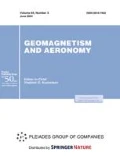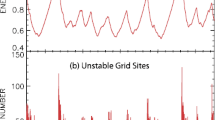Abstract
Self-organization is a property of any nonlinear, dynamic, dissipative system that evolves under the influence of external forces and positive feedback. Self-organization leads to the creation of order from chaos, thus reducing the entropy of the system. As a result, numerous small elements and/or short-lived elements form structures with large spatiotemporal scales. One very important property of a nonlinear, dissipative system is intermittency in space and time, which means that the system is capable of spontaneous transition to a critical state, the so-called state of self-organized criticality (SOC). In this state, small fluctuations can become an impetus for an avalanche of any scale. The object of our research, a constantly evolving convective zone with a magnetic field and turbulent plasma flows, is an ideal example of a nonlinear, dynamic, dissipative system. This review is devoted to the systematization of recent studies on the identification and study of self-organization in the processes of the generation, evolution, and dissipation of magnetic fields on the Sun.
Similar content being viewed by others
REFERENCES
Abramenko, V., Yurchyshyn, V., Wang, H., et al., Scaling behavior of structure functions of the longitudinal magnetic field in active regions on the sun, Astrophys. J., 2002, vol. 577, pp. 487–495.
Abramenko, V.I. and Yurchyshyn, V.B., Intermittency and multifractality spectra of the magnetic field in solar active regions, Astrophys. J., 2010, vol. 722, pp. 122–130.
Aschwanden, M., Scholkmann, F., Béthune, W., et al., Order out of randomness: Self-organization processes in astrophysics, Space Sci. Rev., 2018, vol. 214, pp. 55–130.
Baryshev, Yu. and Teerikorpi, P., Discovery of Cosmic Fractals, World Scientific, 2002.
Brandenburg, A., Sokoloff, D., and Subramanian, K., Current status of turbulent dynamo theory: From large-scale to small-scale dynamos, Space Sci. Rev., 2012, vol. 169, nos. 1–4, pp. 123–157.
Consolini, G., Tozzi, R., de Michelis, P., Complexity in the sunspot cycle, Astron. Astrophys., 2009, vol. 506, pp. 1381–1391.
Feder, J., Fractals, New York: Plenum Press, 1988.
Gershberg, R.E., Aktivnost’ solnechnogo tipa zvezd Glavnoi posledovatel’nosti (Solar-Type Activity in Main-Sequence Stars), Simferopol: Antikva, 2015, ch. 2.5.1.
Kapyla, P.J., Brandenburg, A., Kleeorin, N., et al., Negative effective magnetic pressure in turbulent convection, Mon. Not. R. Astron. Soc., 2012, vol. 422, pp. 2465–2473.
Kitchatinov, L.L., The solar dynamo: Inferences from observations and modeling, Geomagn. Aeron. (Engl. Transl.), 2014, vol. 54, no. 7, pp. 867–876.
Knyazeva, I.S., Makarenko, N.G., Makarenko, I., et al., Analysis of the solar magnetograms evolution using a spectral gap of critical nets, J. Phys.: Conf. Ser., 2016, vol. 738, pp. 1–7.
Krishan, V. and Mogilevskij, E., Self-organization processes on the Sun: The heliosynergetics, Proc. Int. Astron. Union, 1990, vol. 142, pp. 125–133.
Lawrence, J., Ruzmaikin, A., and Cadavid, A., Multifractal measure of the solar magnetic field, Astrophys. J., 1993, vol. 417, pp. 805–811.
McAteer, R.T.J., Gallagher, P., and Ireland, J., Statistics of active region complexity: A large-scale fractal dimension survey, Astrophys. J., 2005, vol. 631, pp. 628–635.
Nagovitsyn, Yu.A., Pevtsov, A.A., and Osipova, A.A., Two populations of sunspots: Differential rotation, Astron. Lett., 2018, vol. 44, no. 3, pp. 202–211.
Nelson, N.J., Brown, B.P., Brun, A.S., et al., Magnetic wreaths and cycles in convective dynamo, Astrophys. J., 2013, vol. 762, pp. 73–92.
Olemskoy, S.V., Choudhuri, A.R., and Kitchatinov, L.L., Fluctuations in the alpha-effect and grand solar minima, Astron. Rep., 2013, vol. 57, pp. 458–467.
Pustil’nik, L.A., Solar flare phenomena as phase transition caused by frustration of current percolation, Space Sci., 1998, vol. 264, pp. 171–182.
Sokoloff, D., Khlystova, A., and Abramenko, V., Solar small-scale dynamo and polarity of sunspot groups, Mon. Not. R. Astron. Soc., 2015, vol. 451, pp. 1522–1527.
Stenflo, J.O., Scaling laws for magnetic fields on the quiet Sun, Astron. Astrophys., 2012, vol. 541, id A17.
Funding
The work was supported by the Russian Science Foundation, project No. 18-12-00131.
Author information
Authors and Affiliations
Corresponding author
Rights and permissions
About this article
Cite this article
Abramenko, V.I. Self-Organized Criticality of Solar Magnetism. Geomagn. Aeron. 60, 801–803 (2020). https://doi.org/10.1134/S0016793220070026
Received:
Revised:
Accepted:
Published:
Issue Date:
DOI: https://doi.org/10.1134/S0016793220070026




